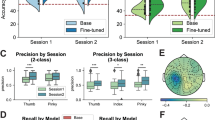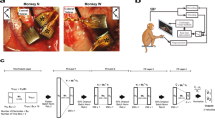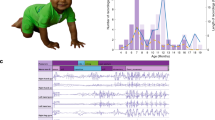Abstract
Imitation of a fine motor movement, index finger protrusion, was examined in 39 neonates using an ethologically based objective coding system. Results confirmed that imitation of finger movements exists, and infants demonstrated “learning” as imitation developed through an incomplete imitation stage. Neonatal imitation was more frequently left-handed, an early sign of laterality in motivation to be investigated further. The existence of index finger imitation in human neonates indicates that volitional control of individuated finger movements develops much earlier than previously thought. The differential increase of index finger protrusion movements during the imitation periods suggests that this behavior is not an automatic response triggered by general arousal but instead is a true indicator of purposeful neonatal imitation.
Similar content being viewed by others

Log in or create a free account to read this content
Gain free access to this article, as well as selected content from this journal and more on nature.com
or
References
Piaget J 1962 Play, Dreams and Imitation in Childhood. Norton, New York
Maratos O 1973 The origin and development of imitation in the first six months of life. Paper presented at the Annual Meeting of the British Psychological Society; April 1973; Liverpool
Meltzoff AN, Moore MK 1977 Imitation of facial and manual gestures by human neonates. Science 198: 74–78
Field TM, Woodson R, Greenberg R, Cohen D 1982 Discrimination and imitation of facial expression by neonates. Science 218: 179–181
Fontaine R 1984 Imitative skills between birth and six months. Infant Behav Dev 7: 323–333
Reissland B 1988 Neonatal imitation in the first hour of life: observation in rural Nepal. Dev Psychol 24: 464–469
Heimann M, Schaller J 1985 Imitative reactions among 14–21 day old infants. Infant Mental Health J 6: 31–39
Abravanel E, Sigafoos AD 1984 Exploring the presence of imitation during early infancy. Child Dev 55: 381–392
Kugiumutzakis G 1999 Genesis and development of early infant mimesis to facial and vocal models. In: Nadel J, Butterwirth G (eds) Imitation in Infancy. Cambridge University Press, New York, pp 22–47
Heimann M 2001 Neonatal imitation—a fuzzy phenomenon? In: Lacerda F, von Hofsten C, Heimann M (eds) Emerging Cognitive Abilities in Early Infancy. Lawrence Erlbaum Associates, London, pp 231–246
Hayes LA, Watson JG 1981 Neonatal imitation: fact or artifact?. Dev Psychol 177: 660–665
Masters JC 1979 Interpreting “imitative” responses in early infancy. Science 205: 215
McKenzie B, Over R Young infants fail to imitate manual and facial gestures. Infant Behav Dev 6: 85–95 1983
Anisfeld M, Turkewitz G, Rose SA, Rosenberg FR, Sheiber FJ, Couturier-Fagan DA, Ger JS, Sommer I 2001 No compelling evidence that newborns imitate oral gestures. Infancy 2: 111–122
Anisfeld M 1979 Interpreting “imitative” responses in early infancy. Science 205: 214–215
van der Meer AL, van der Weel FR, Lee DN 1995 The functional significance of arm movements in neonates. Science 267: 693–695
von Hofsten C 2004 An action perspective on motor development. Trends Cogn Sci 8: 266–272
Nagy E, Molnar P 2004 Homo imitans or homo provocans? The phenomenon of neonatal initiation. Infant Behav Dev 27: 57–63
Nagy E, Molnar P 1994 Homo imitans or homo provocans?. Int Psychophysiol 18: 128
Baldwin JM 1902 Development and Evolution. Macmillan, New York
Jacobson SW 1979 Matching behavior in the young infant. Child Dev 50: 425–30
Thorndike EL 1898 Animal intelligence. An experimental study of the associative processes in animals. Psychol Rev Mon 2: 551–553
Miller NE, Dollard J 1941 Social learning and imitation. Yale University Press, New Haven
Melztoff AN 1988 The human infant as homo imitans. In: Social Learning Psychological and Biological Perspectives. Hillsdale, New Jersey, pp 318–340
Iacoboni M, Woods RP, Brass M, Bekkering H, Mazziotta JC, Rizzolatti G 1999 Cortical mechanisms of human imitation. Science 286: 2526–2528
Wohlschlager A, Bekkering H 2002 Is human imitation based on a mirror-neurone system? Some behavioural evidence. Exp Brain Res 143: 335–341
Meltzoff AN, Moore MK 1983 Newborn infants imitate adult facial gestures. Child Dev 54: 702–709
Heimann M, Nelson KE, Schaller J 1989 Neonatal imitation of tongue protrusion and mouth opening: methodological aspects and evidence of early individual differences. Scand J Psychol 30: 90–101
Meltzoff AN, Moore MK 1997 Explaining facial imitation: a theoretical model. Early Dev Parenting 6: 179–192
Eyre JA, Miller S, Clowry GJ, Conway EA, Watts C 2000 Functional corticospinal projections are established prenatally in the human foetus permitting involvement in the development of spinal motor centres. Brain 123: 51–64
Iacoboni M, Koski LM, Brass M, Bekkering H, Woods RP, Dubeau MC, Mazziotta JC, Rizzolatti G 2001 Reafferent copies of imitated actions in the right superior temporal cortex. Proc Natl Acad Sci USA 98: 13995–13999
Leslie KR, Johnson-Frey SH, Grafton ST 2004 Functional imaging of face and hand imitation: towards a motor theory of empathy. Neuroimage 21: 601–607
Schieber MH 1996 Individual finger movements. In: AM Wing, Haggard P, Flanagan JR (eds) Hand and Brain. Academic Press, San Diego, pp 81–96
Trevarthen C, Kokkinaki T, Fiamenghi G 1999 What infants' imitation communicates. In: Nadel J, Butterworth G (eds) Imitation in Infancy. Cambridge University Press, Cambridge, pp 127–185
Nadel J, Guerini C, Peze A, Rivet C 1999 The evolving nature of imitation as a transitory means of communication. In: Nadel J, Butterworth G (eds) Imitation in Infancy. Cambridge University Press, Cambridge, pp 209–234
Kugiumutzakis G 1999 Genesis and development of early infant mimesis to facial and vocal models. In: Nadel J, Butterworth G (eds) Imitation in Infancy. Cambridge University Press, Cambridge, pp 36–59
Rizzolatti G, Arbib MA 1998 Language within our grasp. Trends Neurosci 21: 188–194
Dehaene-Lambertz G, Pena M 2001 Electrophysiological evidence for automatic phonetic processing in neonates. Neuroreport 12: 3155–3158
Naatanen R, Gaillard AW, Mantysalo S 1978 Early selective-attention effect on evoked potential reinterpreted. Acta Psychol (Amst) 42: 313–329
Huotilainen M, Kujala A, Hotakainen M, Shestakova A, Kushnerenko E, Parkkonen L, Fellman V, Naatanen R 2003 Auditory magnetic responses of healthy newborns. Neuroreport 14: 1871–1875
Kushnerenko E, Ceponiene R, Balan P, Fellman V, Huotilainen M, Naatanen R 2002 Maturation of the auditory event-related potentials during the first year of life. Neuroreport 13: 47–51
Arbib M 2005 From monkey-like action recognition to human language: an evolutionary framework for neurolinguistics. Behav Brain Sci (in press)
Chen R, Gerloff C, Hallett M, Cohen LG 1997 Involvement of the ipsilateral motor cortex in finger movements of different complexities. Ann Neurol 41: 247–254
Natale M, Gur RE, Gur RC 1983 Hemispheric asymmetries in processing emotional expressions. Neuropsychologia 21: 555–565
Adolphs R, Damasio H, Tranel D, Damasio AR 1996 Cortical systems for the recognition of emotion in facial expressions. J Neurosci 16: 7678–7687
Sackeim HA, Gur RC, Saucy MC 1978 Emotions are expressed more intensely on the left side of the face. Science 202: 434–436
Fernandez-Carriba S, Loeches A, Morcillo A, Hopkins WD 2002 Functional asymmetry of emotions in primates: new findings in chimpanzees. Brain Res Bull 57: 561–564
Acknowledgements
We thank the reviewers and Prof. Colwyn Trevarthen for help in writing and editing this article.
Author information
Authors and Affiliations
Corresponding author
Additional information
This study was supported by grant OTKA F023194 from the Hungarian National Research Foundation.
Rights and permissions
About this article
Cite this article
Nagy, E., Compagne, H., Orvos, H. et al. Index Finger Movement Imitation by Human Neonates: Motivation, Learning, and Left-Hand Preference. Pediatr Res 58, 749–753 (2005). https://doi.org/10.1203/01.PDR.0000180570.28111.D9
Received:
Accepted:
Issue date:
DOI: https://doi.org/10.1203/01.PDR.0000180570.28111.D9
This article is cited by
-
Understanding Selfhood to Elucidate the Phenomenology of Mindfulness
Philosophia (2022)
-
The ‘We’ in ‘Me’: An Account of Minimal Relational Selfhood
Topoi (2020)
-
Biosocial selfhood: overcoming the ‘body-social problem’ within the individuation of the human self
Phenomenology and the Cognitive Sciences (2018)
-
Impact of perinatal different intrauterine environments on child growth and development in the first six months of life - IVAPSA birth cohort: rationale, design, and methods
BMC Pregnancy and Childbirth (2012)


